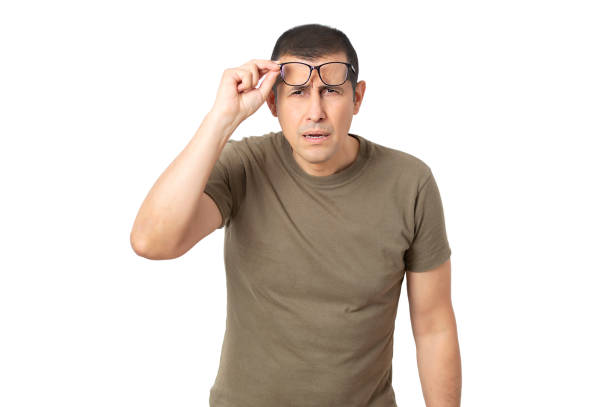After turning 40, you find it difficult to read or focus on close-up objects. Perhaps you’ve tried wearing readers that you purchased at the store, but your eye doctor advises wearing progressive lenses. Do you want to jump in?
Table of Contents
What Are Progressive Lenses?
A progressive lens, which enables the incorporation of multiple vision fields into a single lens without any discernible distinction between the fields themselves, is an amazing feat of engineering. From far-to-intermediate to your full reading power, the lens power “gradually” increases. This is the reason why “no-line” bifocals or trifocals are another name for progressive lenses.
Presbyopia is a vision condition characterized by a loss of the ability to focus clearly on close objects, which is why progressive lenses are best for patients who have it.
Our capacity to see things close by and far away may deteriorate as we get older naturally. Progressive lenses combine two visual fields—one for “distance viewing” and the other for “near vision”—to address two distinct visual needs in one lens. In place of a line dividing these regions, they are “blended” together, with the middle part of the lens frequently acting as an intermediate vision corrector when necessary.
Progressive lenses have no visible lines dividing the various fields, in contrast to traditional bifocals or trifocals. There are no “lens lines” to obstruct your vision, your eyes can be seen clearly behind the progressive eyeglasses, and you resemble eyeglass wearers who are frequently half your age.
People Who Wear Progressive Lenses
The majority of people with vision issues can wear these lenses, but presbyopic (farsighted) people over 40 who experience blurry vision when performing close-up tasks like reading or sewing usually require them. Children can also use progressive lenses to stop their nearsightedness from getting worse.
If progressives are a possibility for you, discuss it with your doctor.
Progressive Glasses: Pros And Cons
You should be aware of the advantages and other considerations before switching to progressive lenses if you’re thinking about doing so.
Progressive Lens Benefits
Many different ways progressive lenses can be good for your eyes.
1. For Every Activity, You Won’t Need More Than One Pair Of Glasses.
When you wear progressive lenses, you won’t have to switch your prescription glasses for reading glasses, computer glasses, or anything else, and you won’t lose track of where you last put them. (You won’t need to remove your reading glasses any longer! Due to the fact that you are not removing the frames, you are also less likely to lose them.) You have access to any prescription you might require for near, middle, or far vision.
So, while wearing the same pair of glasses, you could read a travel book, research a destination online, and then drive there while reading the road signs. (We can also provide them with blue-light protection at Warby Parker!)
2. Progressive Lenses Don’t Have An Annoying “jump” Between Lens Powers.
When you use bifocals or trifocals, switching between the various powers on the lens can produce an “image jump,” or the perception that the object you’re looking at has suddenly moved. Jumps like these can be annoying or worse: in severe cases, they can lead to nausea.
As you transition from one prescription strength to another, progressives prevent jumps by blending the various powers together smoothly and without lines.
3. Progressives Can Help You Stand More Upright And May Even Help You Avoid Computer Vision Syndrome.
Progressive lenses may be less taxing on your neck and posture than bifocals. In order to find the best viewing zone for a particular object, bifocal users frequently have to keep craning or moving their heads as they switch between the top and bottom viewing fields of their lenses.
Due to the fact that bifocals have two zones designed for near and far vision, intermediate viewing can be difficult. Therefore, it can be particularly challenging and make the symptoms of computer vision syndrome worse to stare at a screen for extended periods of time. (Bifocals are less well-suited for the distance between you and a laptop that is resting on your desk because they were more popular before we all became computer-dependent.)
These problems might be resolved with progressive lenses. To make switching between lenses simpler, they have a middle zone designed for intermediate vision that blends into the top and bottom of the lens.
4. Progressives Don’t Make A Big Deal Out Of Their Age Or Themselves.
Wearing bifocals or trifocals with glaring lines on the lenses may be perceived by some as an unfavorable sign of advancing years. Others might merely prefer eyewear with a more uniform, natural presentation.
With uninterrupted and transparent lenses, progressives closely resemble “regular” prescription glasses. Additionally, just like with any eye prescription, you can select eyeglasses that complement your personal style; take our quiz to learn which eyeglass frame designs you prefer.
5. Contacts And Progressives Go Well Together.
Once you start wearing progressives, you can continue to alternate between wearing contacts and glasses if you normally wear both. Similar to progressive lenses, multifocal contact lenses have various zones built into their design for various types of distance viewing.
Another option is to use monovision lenses. With these lenses, one eye corrects for distance vision while the other corrects for close-up vision. Your brain eventually learns to use the proper eye depending on what you’re trying to view.
If you believe you would make a good candidate for either multifocal or monovision contacts, speak with your optometrist.

Progressive Lens Drawbacks
Fortunately, the disadvantages of wearing progressive lenses are generally minor and transient.
1. It May Take Some Time To Get Used To Wearing Progressive Lenses.
Progressive lens acclimatization mainly requires patience and practice. You’ll need to get used to using the various parts of the lenses to see at various distances.
For distance vision, you are typically instructed to look straight ahead. For intermediate vision, you are advised to look a little below eye level. For close-up tasks, you are advised to look even lower. It can take a week or more to get used to these zones, and in some cases, it can make you feel queasy or nauseous.
Progressives can initially lead to some visual alterations in your peripheral vision. Give yourself some time to adjust if you notice that looking to the sides causes your vision to become blurry. As you get more comfortable with your glasses, these effects should lessen.
Having your new pair customized to your face is also beneficial! You can always visit Warby Parker to have your frames customized to your features for free lifetime adjustments.
2. Other Multifocal Lenses Are Less Expensive Than Progressive Lenses.
Progressives might seem like a more expensive option than bifocals and trifocals. However, most users believe that the cost is justified given their practical, streamlined design and the fact that they correct vision at a wide range of distances.
Tips For Wearing Progressive Lenses
- Practice turning your head, rather than just your eyes, in the desired direction. If you don’t, you might switch fields too quickly and obstruct your vision by darting your eyes back and forth.
- Try not to look at your feet or the ground while you are walking; instead, look straight ahead. Looking down at your feet can distort your vision because your lenses’ bottoms are usually designed for close-up work.
- As often as you can, put on your progressive lenses to get used to them. In spite of this, feel free to gradually increase the length of time you wear them by keeping an eye out for any visual occlusion or discomfort. (Any eyewear that consistently makes you feel uncomfortable should never be continued!)
- Never deviate from the recommendations and instructions of your eye doctor. Let them know if you’re having trouble getting used to your progressives so they can change your prescription, evaluate how well your glasses fit, or provide you with more assistance.


